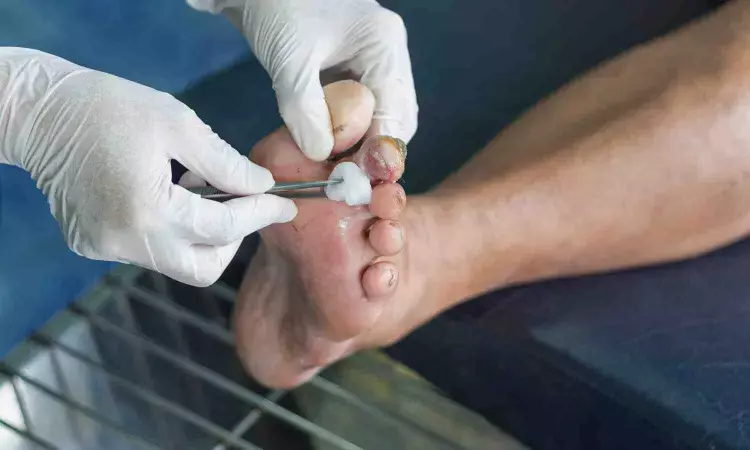- Home
- Medical news & Guidelines
- Anesthesiology
- Cardiology and CTVS
- Critical Care
- Dentistry
- Dermatology
- Diabetes and Endocrinology
- ENT
- Gastroenterology
- Medicine
- Nephrology
- Neurology
- Obstretics-Gynaecology
- Oncology
- Ophthalmology
- Orthopaedics
- Pediatrics-Neonatology
- Psychiatry
- Pulmonology
- Radiology
- Surgery
- Urology
- Laboratory Medicine
- Diet
- Nursing
- Paramedical
- Physiotherapy
- Health news
- Fact Check
- Bone Health Fact Check
- Brain Health Fact Check
- Cancer Related Fact Check
- Child Care Fact Check
- Dental and oral health fact check
- Diabetes and metabolic health fact check
- Diet and Nutrition Fact Check
- Eye and ENT Care Fact Check
- Fitness fact check
- Gut health fact check
- Heart health fact check
- Kidney health fact check
- Medical education fact check
- Men's health fact check
- Respiratory fact check
- Skin and hair care fact check
- Vaccine and Immunization fact check
- Women's health fact check
- AYUSH
- State News
- Andaman and Nicobar Islands
- Andhra Pradesh
- Arunachal Pradesh
- Assam
- Bihar
- Chandigarh
- Chattisgarh
- Dadra and Nagar Haveli
- Daman and Diu
- Delhi
- Goa
- Gujarat
- Haryana
- Himachal Pradesh
- Jammu & Kashmir
- Jharkhand
- Karnataka
- Kerala
- Ladakh
- Lakshadweep
- Madhya Pradesh
- Maharashtra
- Manipur
- Meghalaya
- Mizoram
- Nagaland
- Odisha
- Puducherry
- Punjab
- Rajasthan
- Sikkim
- Tamil Nadu
- Telangana
- Tripura
- Uttar Pradesh
- Uttrakhand
- West Bengal
- Medical Education
- Industry
What are advancements and best practices for management of diabetic foot complications?

India: As diabetes rates rise globally, diabetic foot care has become a vital focus in healthcare. A recent review published in Diabetes Research and Clinical Practice outlines significant advancements and best practices in managing diabetic foot complications, including foot ulcers, neuropathy, vascular disease, and amputation risks.
A central theme of the review is the necessity of a multidisciplinary approach. The collaboration of diabetologists, podiatrists, vascular surgeons, and wound care specialists is crucial for improving patient outcomes. This teamwork enables healthcare providers to deliver comprehensive care that addresses the multifaceted complications associated with diabetes.
Innovative wound management techniques are among the key advancements highlighted. The review emphasizes the effectiveness of advanced dressings and bioengineered skin substitutes, which enhance healing and lower infection risks. Additionally, offloading devices, such as total contact casts and specialized footwear, are essential in preventing pressure-related injuries, particularly for patients with existing ulcers.
Early detection and intervention are also critical components of diabetic foot care. The review stresses the importance of conducting vascular evaluations as a baseline investigation. Assessments like the Ankle-Brachial Index (ABI) and Toe-Brachial Index (TBI), carried out by trained podiatrists, can help identify peripheral artery disease (PAD) early. Techniques such as arterial color Doppler and duplex scans are valuable for diagnosing vascular issues that may lead to foot complications.
Technological innovations further enhance diabetic foot care. Telemedicine platforms enable remote consultations and continuous monitoring, while wearable devices allow for real-time tracking of foot health, facilitating timely interventions. Mobile applications are vital educational resources, helping patients adhere to foot care routines.
Despite these advancements, significant disparities in access to care and treatment outcomes persist globally. Socioeconomic factors, healthcare infrastructure, and the availability of specialized services contribute to these inequalities, resulting in varied management and outcomes for diabetic foot complications.
Addressing these challenges requires concerted efforts from policymakers, healthcare providers, and community organizations to ensure equitable healthcare access for all individuals with diabetes. By synthesizing the latest advancements and best practices, this review aims to support ongoing efforts to improve the quality of life for those affected by diabetic foot conditions worldwide.
"This comprehensive review serves as an essential resource for healthcare professionals, policymakers, and researchers dedicated to advancing diabetic foot care," concluded authors Smita Kumbhar and Manish Bhatia, from India. They emphasize the need for continued research and policy initiatives to enhance global patient outcomes and advocate for a collaborative, patient-centered approach in managing this critical aspect of diabetes care.
Reference:
Kumbhar, S., & Bhatia, M. (2024). Advancements and best practices in diabetic foot Care: A comprehensive review of global progress. Diabetes Research and Clinical Practice, 217, 111845. https://doi.org/10.1016/j.diabres.2024.111845
Dr Kamal Kant Kohli-MBBS, DTCD- a chest specialist with more than 30 years of practice and a flair for writing clinical articles, Dr Kamal Kant Kohli joined Medical Dialogues as a Chief Editor of Medical News. Besides writing articles, as an editor, he proofreads and verifies all the medical content published on Medical Dialogues including those coming from journals, studies,medical conferences,guidelines etc. Email: drkohli@medicaldialogues.in. Contact no. 011-43720751


